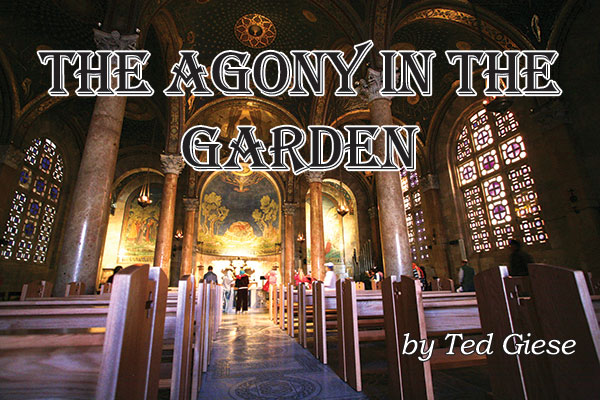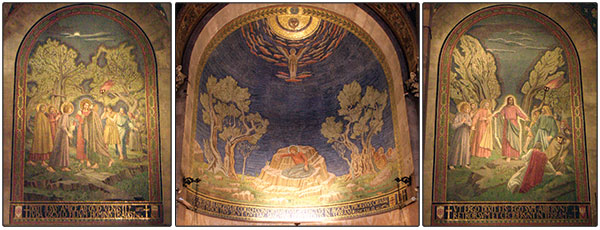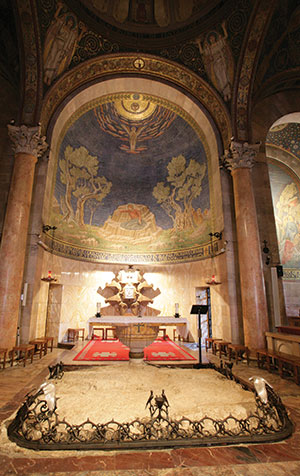The Agony in the Garden

by Ted Giese
Recently I had the privilege to take part in Canadian Lutheran World Relief’s (CLWR) 2014 Global Encounter, held in Israel and Palestine. In addition to visiting places like the Augusta Victoria Hospital and various Lutheran schools which are supported in part through funding from CLWR, I also had the opportunity to see many locations connected to the life and work of Jesus. One such place was the Mount of Olives.
On the Mount of Olives in the Garden of Gethsemane in the dark of night, Jesus prays, “Father, if You are willing, remove this cup from Me. Nevertheless, not My will, but Yours, be done.” The Gospel according to St. Luke continues the account: “There appeared to Him an angel from heaven, strengthening Him. And being in an agony He prayed more earnestly; and His sweat became like great drops of blood falling down to the ground” (Luke 22:42-44). This time of prayer, which comes after the institution of the Lord’s Supper and before Jesus’ arrest and crucifixion, is the inspiration for a monumental church building located on the site traditionally associated with the Garden of Gethsemane.
The church is called the Basilica of the Agony and it was commissioned by the Custodian of the Holy Land, the Franciscan Father Ferdinado Diotallevi, in the early 20th century. Completed in 1924, it was designed and decorated by Antonio Barluzzi who is affectionately referred to as the Architect of the Holy Land. Barluzzi built, restored, and renovated around twenty major religious structures, hospitals, and schools in the Holy Land and area. He worked with the idea that when building a house of God, the keystone must be beauty and artistic skill. The Basilica of the Agony and his other monumental church buildings show this concept in action. The Basilica of the Agony is a work of art and architecture in the heart of the Holy Land that tells in stone and mosaic tiling the love of Jesus for you as He suffered in the Garden of Gethsemane in anticipation of His coming passion.
Barluzzi’s church on the Mount of Olives remembers Christ Jesus in the olive press of Gethsemane and appropriately ponders this wondrous and agonizing night.
Gethsemane is a Greek form of the Hebrew gat shemanim which means “oil press.” In the Holy Land, olive oil is an important part of life. It was used for lighting lamps in the night, used day in and day out to prepare meals both ordinary or consecrated, and used on more rare occasions to anoint kings. Barluzzi’s church on the Mount of Olives remembers Christ Jesus in the olive press of Gethsemane and appropriately ponders this wondrous and agonizing night.
Jesus says, “I Am the light of the world. Whoever follows Me will not walk in darkness, but will have the light of life” (John 8:12).
Inside the church is very dark, even when entered in the bright sun of mid-day. Barluzzi designed it this way so that the person entering would contemplatively enter into the moonlit agony of Jesus’ heavy-laden heart that night in the Garden. Translucent alabaster windows provide to the sanctuary a light the colour of the penitential season of Lent. This deep violet hue gradually bathes the space as the eye adjusts to the dark. Slowly details within the church begin to emerge out of the dimness. The longer a person spends in the space, the more they are able to see Jesus there in the dark.

Triptych images from the interior of the Basilica of the Agony.
Jesus, The Light of the World, is shown in a large mosaic triptych at the front of the church. On the left, Judas betrays Jesus with a kiss. In the centre, Jesus prays on a stone with a single angel hovering high over head. On the right, Jesus is presented as the Light in the darkness (John 1:5) who is voluntarily taken to trial. This third part of the triptych shows Jesus and the men who come to arrest Him in the Garden. He asks “Whom do you seek?” and the men say “Jesus of Nazareth.” The mosaic shows the moment when Jesus answers them, saying “I Am He” as the men draw back and fall to the ground (John 18:6).
St. Paul writes, “For as often as you eat this bread and drink the cup, you proclaim the Lord’s death until He comes” (1 Corinthians 11:26).
Sometime you’ll hear the phrase “He was put through the wringer.” This references an old-fashioned way of drying clothes. Wet clothes would be run between a series of tight rollers to wring the water out. In the same way, olive presses were used to crush olives and press the oil out so it could be collected. Jesus’ night in the garden was like the olive press for which the garden was named.
The olive press and the fruit of the olive are regularly associated with food preparation in the Holy Land. So too, Jesus’ time in the Garden that night is part of the preparation for our most important meal as Christians. Many Lutheran churches place a crucifix on or above the altar to remind us that the Jesus who hung upon the cross is the very same Jesus who is present in the Lord’s Supper.
For Lutherans, the events of Holy week are all wrapped up in the celebration of this simple meal of bread and wine that Jesus promises to be present in. In the Sanctus, we sing the words of Palm Sunday (“Hosanna! Blessed is He who comes in the name of the Lord”). In the Words of Institution, we recount the words of Jesus from Maundy Thursday: “Take, eat; this is my body. Drink of it, all of you, for this is my blood.” Through the presence of His Body and Blood with the bread and wine, we have His crucifixion and His resurrection present for us. We therefore also have forgiveness of sins and the promise of our own resurrection.
Within the walls of the Basilica of the Agony, the Christian is reminded that in the Supper we also have Christ’s agony in the Garden. Before the altar, breaking the surface of the floor, is a large piece of exposed rock. The church is built around it and it is the same kind of stone that makes up the Mount of Olives. Traditionally, Christians have envisioned Jesus praying on this kind of stone.
Wreathing this exposed rock is a low standing iron and silver sculpture depicting a crown of thorns. Woven into this crown of thorns are three cups with two doves at each cup. This draws to mind the cup of the Last Supper, the cup which Jesus prays would pass from Him in the garden, and the cup of God’s wrath over our sins. While Barluzzi physically depicts these as three separate cups, in Christ Jesus they are one and the same. Through His agony and death, Jesus makes this cup a cup of blessing for Christians. With artistic imagery like this, Barluzzi commemorates that difficult night in Gethsemane in which Jesus’ gracious and merciful love for the world shone in the darkness.
“He has caused His wondrous works to be remembered; the LORD is gracious and merciful” (Psalm 111:4).

The rock before the altar, with the iron and silver ‘crown of thorns’ encircling it. Note the cups between the sitting doves.
Through this building, Barluzzi confesses that “the Word became flesh and dwelt among us” (John 1:14). And while we wait to see Jesus’ glory with our own eyes, Barluzzi tells the story of Apostles who, as St. John puts, “have seen His glory, glory as of the only Son from the Father, full of grace and truth” (John 1:14).
There is in the twelve vaulted mosaic domes of the church, with their deep blue tiles and twinkling stars, an honesty about the dark times of suffering Christians face in this life. There is likewise the reassurance that Christ Jesus suffered not just physical death at the cross but also the anguish and agony of spiritual pain—invisible lashes which afflict the soul in this fallen world. The Apostles were witnesses to this suffering, and they lovingly hand the story down to you and me. Through his architecture, Barluzzi does the same.
Because the church is so different from some of the other churches in the Holy Land, it can be puzzling to some who encounter it. Is it a beautiful place? Can there be any beauty in the darkness of Gethsemane? Beauty for Barluzzi, it is clear, includes more than what is found in a Thomas Kinkade painting. Barluzzi’s work includes the chiaroscuro of Caravaggio and the grim emotion of Grünewald’s Isenheim Altarpiece.
As with all church art, one of the questions to ask is this: ‘What is appropriate for the place?’ For Barluzzi, the place itself suggests how best to approach the art and architecture of the church. Barluzzi explains it in this way: “In Palestine every holy place has a direct reference to a definite Mystery of the life of Jesus Christ…. Rather than choosing the art form first, and bending everything else to suit it, I think it is more fitting to establish the basic religious concept of the holy place for which the sanctuary is being built and tailor the architecture to it.” In the Basilica of the Agony, Barluzzi follows his own advice and gives the Christian a church that paints in stone the mystery of that night.
The Holy Land is a wondrous and challenging place to visit. As time marches on, the stone and tile of the Basilica of the Agony will stand as a testimony to the incarnation—the revelation that God didn’t save us from afar but rather came in the flesh to suffer what we suffer.
The Basilica of the Agony stands as a testimony to the incarnation—the revelation that God didn’t save us from afar but rather came in the flesh to suffer what we suffer.
As Christians in the Holy Land experience suffering, they too can feel as if they were also caught in the olive press of Gethsemane. They, and we with them, can rest assured that we have a Saviour in Christ Jesus who sympathizes with our agony. The Basilica of the Agony is a monument to this truth—an encouragement to all Christians who struggle in this fallen world with hardships of any and every kind.
It is important, however, to remember Christ’s work did not end in Gethsemane. Nor did it end at the cross. On Easter morning, the tomb was empty. Jesus lives. He is who He said He was—“The Resurrection and the Life” (John 11:25). The Basilica of the Agony provides for Christians a place to contemplate the scope of Jesus’ love for them, remembering His agony and—Good News!—His grace and mercy.
———————-
Rev. Ted Giese is associate pastor at Mount Olive Lutheran Church in Regina, Saskatchewan.
Title photo, centre triptych photo, and altar rock photo: Sveltana Frechkina (www.flickr.com/photos/womeos/), adapted under Creative Commons Attribution-Share Alike 2.0 Generic License. Left and right triptych photos: Mathew Block.




